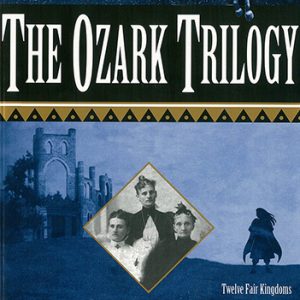calsfoundation@cals.org
The Ozark Trilogy
The Ozark Trilogy (1981) is a science fiction trilogy by Suzette Haden Elgin set on the fictional planet Ozark. In Elgin’s story, Ozark has been colonized by twelve families from the Ozark region of Earth who name the continents Arkansaw, Mizzurah, Marktwain, Oklahomah, Tinaseeh, and Kintucky. The families fled Earth in 2012 to escape the poverty, disease, and violence of a failing civilization and its corrupt central government. The Trilogy begins 1,000 years later, as the old questions of power and the role of government resurface, and the Ozarkers must decide what kind of civilization they will be.
Elgin, who grew up in the Missouri Ozarks and retired to the Arkansas Ozarks in the 1980s, draws heavily upon Ozark culture and language for the book. Elgin’s characters, especially women, practice Ozark folkways, including folk music, traditional medicine, textile arts, and storytelling. In many ways, the society on Ozark is pre-industrial—even medieval—as characters live in castles and eschew motorized transportation. However, futuristic technology is employed for communication systems and some medicine. Much of the Ozarkers’ medical treatment, transportation, and communication depends upon another force on Ozark—magic. Flying donkeys, spells, potions, prophecies, and magicians can all be found on planet Ozark.
The first part of the trilogy, Twelve Fair Kingdoms, centers on Responsible of Brightwater, a young woman from the Marktwain continent who uses powerful magical abilities to keep her continent in order. She also takes on the weight of policy and logistical problems throughout the twelve kingdoms. There is a chosen “Responsible” in every generation who has magical powers beyond even the most powerful “Grannies” or “Magicians of Rank” present in every prominent household. Much of Responsible’s work, like negotiating with the indigenous species, goes on in secret and without reward. Responsible’s accomplishments and rare power inspire envy and suspicion among some Ozarkers, who become her secret enemies.
In the second part, The Grand Jubilee, Responsible’s enemies have found a way to derail the Jubilee—a meeting of all the families that happens only once every 500 years—by persuading the prominent Ozark families to dismantle the “Confederation of Continents” that has always united them in one central government. Responsible’s enemies place her in a magic-induced coma that prevents her from her usual duties. Ozark society quickly begins to deteriorate without her leadership; her magical powers, it turns out, were necessary for all magical energy to function on Ozark.
In the third part, And Then There’ll Be Fireworks, the planet Ozark has plunged into a dark age lacking communication, infrastructure, technology, industry, and—most importantly—the magic Ozarkers depended upon. The economy has failed, and the people of continent Arkansaw (called “Arkansawyers”) have broken out in a civil war. The conflict is chiefly felt among three families—the Farson, Purdy, and Guthrie families—who had been feuding for decades. Meanwhile, a powerful neighboring civilization, called the “Out-Cabal,” plans to conquer planet Ozark. The Out-Cabal have a rule that they can only conquer another planet if it clearly has dissolved into violence and anarchy. To save the planet, Responsible must be awakened to unite the kingdoms once again. This is accomplished with the help of the indigenous people and their magic spring. Upon waking, Responsible restores planetary communications and magic. Delegates from the twelve kingdoms are immediately elected and vote in favor of restoring the Confederation of Continents. The Out-Cabal retreat, but not without an ominous warning that they will forever be watching Ozark.
In addition to the inclusion of traditional Ozark folkways, Elgin imbues her characters with traditional values such as frugality, industry, simplicity, and endurance. Elgin also includes traditional linguistic forms and practices in the narrative, especially Twelve Fair Kingdoms, the story of which is narrated through Responsible’s consciousness, often relating even factual events in a way that emphasizes Ozark pronunciation. (The most common example is spelling “have” as “of” so that phrases like “would have” are rendered “would of.”) Ozarkers also use some vocabulary from Ozark English, such as “flags” to refer to orange lilies. Ozark English syntax is also present in the book, especially double-modal constructions like “might should.” Even before becoming a science fiction writer, Elgin was a noted feminist and linguist, which is evident in the prevalence of strong women in The Ozark Trilogy and in the emphasis on the power of language.
The Ozark Trilogy was first published by Doubleday in New York in 1981 as three separate books and then in 1982 as an omnibus. In 1983, the trilogy was re-published by Berkley Books of New York. It subsequently went out of print until the University of Arkansas Press published the trilogy again in 2000. The trilogy was well reviewed, including a positive review of the first book, Twelve Fair Kingdoms, by the L.A. Times Review of Books, and has been popular chiefly among science fiction and fantasy audiences. While this trilogy is overshadowed by Elgin’s more popular Native Tongue trilogy, it is still often discussed by the science fiction/fantasy community, especially those interested in women’s science fiction.
For additional information:
Little, Judith. A. Feminist Philosophy and Science Fiction: Utopias and Dystopias. Amherst, NY: Prometheus Books, 2007.
Staicar, Tom. The Feminist Eye: Science Fiction and the Women Who Write It. New York: F. Ungar Publishing Company, 1982.
Carly Houston Overfelt
University of Massachusetts, Amherst


 The Ozark Trilogy
The Ozark Trilogy 



Comments
No comments on this entry yet.